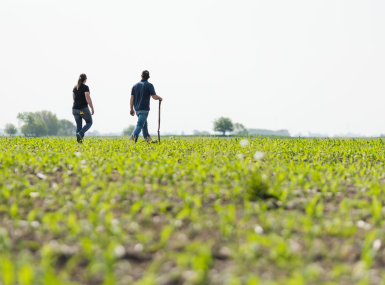LUCC, RAC members talk housing, hunger as pandemic continues

Key Takeaways
Though caution with regard to the COVID-19 pandemic forced NACo to hold its Fall Board Meeting and Large Urban County Caucus/Rural Action Caucus (LUCC/RAC) Symposium online instead of in person in Boone County, Ky., the change opened up programming to more members.
The Dec. 10 programming mostly spanned the urban-rural divide, tackling problems that affect counties in different ways, yet have impacts on residents that have been exacerbated by the pandemic.
LUCC/RAC members heard from the Centers for Disease Control and Prevention (CDC) representatives about the county role in the distribution of the COVID-19 vaccine in both rural and urban communities.
With an approved vaccine on the horizon, the director of the National Center for Immunization and Respiratory Diseases at the CDC, Nancy Messonnier, reviewed the vaccine’s development plan and stressed to county officials the importance of informing communities about the planning process for vaccine distribution.
“One thing you need to be doing now is engaging your communities in sustainable, equitable and inclusive ways so that they are engaged in the planning process and are ready to accept the vaccine when it becomes available,” she said.
The CDC’s LeAnne Fox explained the Vaccinate with Confidence initiative which aims to promote confidence in all vaccines. The campaign includes a multi-faceted communication toolkit that provides information to health care providers, fact sheets, posters and concepts for social media posts.
When it comes to providing the COVID-19 vaccine to specific populations, Fox said the CDC is working with pharmacies and jurisdictions to reach those in rural communities and start vaccinating essential rural workers as distribution phases progress. For incarcerated individuals, she explained the Bureau of Prisons is receiving a separate allocation of vaccines to distribute among jails.
“Vaccination planning is really a combination of state, territorial, tribal and local responsibility and so we work in close partnership,” Fox said. “It’s very important we understand each other’s roles and we work to be as efficient as possible with the funding we have so we can access the greatest population and provide coverage to as many people as possible.”
Housis crisis predated pandemic
Tim Shaw, a senior policy manager at the Aspen Institute, which focuses on policy at the household level, identified four areas of housing crisis that were relevant even before the pandemic. He explained that there is a lack of new housing to meet growing demand, families are unable to afford housing options available to them, there is often discrimination harming people of color and that current policies disadvantages renters.
While Shaw explained that all four of these aspects affect communities differently, he said they can be narrowed down to unaffordability and instability.
“Our diagnosis is there has been insufficient public investment,” he said. “There’s just a gap between public money that we have in the system that would allow people to have affordable and stable housing and the amount that people need.”
COVID-19 Eviction Defense Project Co-Founder Sam Gilman said the added challenges from the pandemic have only exacerbated housing issues.
According to a study released in August, nearly 30 million people are at risk of eviction by the end of the year, one in six renters are behind on rent and more than 25 percent are labeled as “housing insecure,” according to the U.S. Census Bureau.
Gilman said new research has suggested there is a correlation between evictions and increased COVID-19 spread and deaths.
“Housing stability is very much tied to pandemic response from an economic perspective, but also from a public health perspective,” he said.
To combat these challenges, Shaw recommends local governments take action to keep individuals housed during the public health and economic crises.
If states do not have a moratorium on evictions, he recommends counties issue their own and prohibit initial eviction paperwork filing during the moratorium. Shaw said it is important to ensure temporary housing is available and to consider using funds to support emergency rental assistance.
During this public health crisis, it is important to ensure there are housing options residents can afford to support their health that are free of respiratory hazards and overcrowding, he said.
Shaw added that awareness is a key factor in running housing programs to ensure individuals are aware rental assistance programs exist.
“Awareness is a big problem for people getting to know whether or not they have resource available to them,” he said.
Urban county officials also heard from the U.S. Department of the Treasury on how counties can ensure they’re complying with the Dec. 30 federal deadline for spending CARES Act funds and meeting all reporting requirements.
Audit Director Eileen Kao from the Office of the Inspector General in the U.S. Department of Treasury reviewed how counties can spend CARES funding and the ways to report financial progress reports.
She discussed how CRF payments must be used on necessary expenditures incurred because of the public health emergency and are unable to be used for revenue replacement.
Visit the Treasury’s website for coronavirus relief fund guidance for state, territorial, local and tribal governments and coronavirus relief fund reporting and record retention requirements.
Pandemic amplifies hunger problem in rural, urban counties
As the pandemic drove people to stay home, forcing some out of work, the economic repercussions quickly reached their food supplies. This cut across demographics, affecting rural and urban counties alike and in many cases amplifying existing systemic problems and inequities.
The pandemic struck right at the high point of harvest season in Palm Beach County, Fla., the largest agricultural producer east of the Mississippi River.
“We suffered almost a half-billion-dollar loss to our farmers, and at the same time, families suddenly found themselves in need,” said Commissioner Melissa McKinlay, whose district includes that agricultural area. “There was significant pressure for stay-at-home orders; we made sure the Department of Homeland Security classified agricultural workers as essential so we could keep them going.”
In addition, many migrant seasonal workers were unable to travel home because of COVID-19 restrictions, and many lived and worked in congregate settings that would make coronavirus transmission easy, so further work with the Department of Homeland Security was necessary.
At the same time, most of the buyers for that food — hotels and cruise lines — were doing little to no business, but there was no distribution connection between the growers and everyday consumers in the existing economic system. Working with the state commissioner of agriculture and trade groups, farmers were able to develop a direct-to-consumer database and create new farmers’ markets to keep that food from going to waste.
“We emptied a semi-truck full of sweet corn in less than an hour,” McKinlay said. “We had an overabundance of crops and an overabundance of need and trying to match up those two resources, while at the same time having to ensure the safety of our farm workers.”
Like the COVID tinderboxes of meat packing plants in the Midwest, vegetable packing plants in Florida also posed fertile ground for disease transmission.
“We’ve put a lot of significant resources into testing and tracing,” McKinlay said, in advance of the new harvest season, which began in October.
Before the pandemic, Dayton, the seat of urban Montgomery County, Ohio, was recognized as the fourth hungriest city in the country.
“We were already facing a crisis,” said Debbie Lieberman, a Montgomery County commissioner. “Then the pandemic struck, and it’s brought to light to the whole community how bad it really is.”
Food deserts pose the largest problem for Montgomery County residents, because there are fewer existing distribution points for fresh food in large swaths of half of the county. The county has put more than a half million dollars into a mobile grocery market that travels to the county’s food deserts, and its food banks have distributed 14 million pounds of food in eight months.
An added 18,7000 Supplemental Nutrition Assistance Program (SNAP) applications brought the county’s total to 34,000 households.
“Hunger is really at the root of a lot of our issues here,” she said. “We have a food equity plan that we were doing pre-pandemic, but it brings together all of our nonprofits. Our food bank has 160 partners. We’re doing a lot of work, but it’s not enough.”
The topography of rural, mountainous Wilkes County, N.C. exacerbates its food deserts. Heather Murphy, executive director of The Health Foundation, knows of people who had to take two-hour bus trips to the grocery store for a journey that covers a mile.
“With our rural transportation system, you go around your elbow to get to your knee,” she said. “It is difficult to think of hunger in isolation of other issues that our community faces. Transportation is a huge barrier for people regardless of whether there’s a pandemic.”
The local food pantries have combined to buy local produce and sell it, accepting EBT and SNAP benefits, at six sites throughout the county via a mobile food pantry.
Murphy said that job losses during the pandemic have increased food pantry use by 30-50 percent.
“People were showing up to a food pantry for the first time — you can imagine what it felt like for those households who were used to being able to provide for themselves and finding themselves in a situation where they couldn’t. It was quite devastating.”
Murphy said that charitable care nonprofits initially saw their volunteers, many of whom were older and in high-risk populations, withdraw out of concern for their health. Habitat for Humanity volunteers, who were idled, came in to take their place.
“They said they had young able people, ready to help,” Murphy said.
They were able to deliver food through Meals on Wheels in lieu of congregate dining facilities that were not safe during the pandemic.
“If it weren’t for the partnerships we had with our rural communities, we couldn’t have pulled off the things we did,” Murphy said.
Innovation, new technology needed for post-COVID economy
When it comes to the future of local economies, the COVID-19 pandemic has shed light on the need for innovation to enhance the workforce for new environments.
County officials discussed ways to “future-proof” local economies Thursday, Dec. 10 during the Large Urban County Caucus (LUCC)/Rural Action Caucus (RAC) Symposium.
With costs rising, revenues declining and counties receiving fewer state funds because of the public health crisis, local governments are experiencing impacts to their budgets and are looking to find innovative solutions to meet the needs of their communities in a post-COVID-19 economy.
For Franklin County, Ohio, Commissioner John O’Grady, the focus of workforce development and job sector shifts during these challenging times are viewed through the lens of small businesses.
“Small businesses are crucial to every community and we believe that they truly are the backbone of the economy,” he said.
Officials in Franklin County created several programs to aid more than 900 small businesses during the pandemic, including using recovery grants and safety grants to allow businesses to reopen safely. The county also collaborated with the City of Columbus to create programs and help businesses that still needed support.
In Wise County, Texas, Judge J.D. Clark said the county has focused on diversifying the economy even prior to the pandemic by establishing a tax increment refinance zone that revitalized a downtown main street area.
“The business development has followed,” he said.
To supply employees for these new businesses, the county partnered with a local college to offer new programs for workforce development training.
When the pandemic rolled around last spring, Wise County officials established similar programs to Franklin County and launched the Wise Recovery Program to provide funding to small businesses that were forced to shut down.
“It comes down to communication and trying to understand what the businesses need,” Clark said.
Author and futurist Shawn DuBravac said when it comes to future-proofing local economies, it is necessary to provide the skill set for resilient jobs and source workers from local areas.
“I think that becomes the key piece of it— building some of that resiliency in recognizing that even as we come through the pandemic, things will inevitably be different,” he said.
As economies adjust to the new normal and prepare for the future of work, accessibility challenges with broadband coverage have become prioritized as both rural and urban communities realized the urgent need for broadband coverage.
“We also were able to shine a spotlight on the fact that digital divides exist everywhere, it’s not just a far-flung rural problem, but you can have barriers to internet access even in the dense urban areas,” Clark said.
In Wise County, Clark said it’s going to take more broadband investments to provide access to all his constituents.
“This isn’t about being able to stream Netflix at night, this is about your kid being able to do their final exam,” he said.
In Franklin County, O’Grady discussed broadband challenges when students returned to online learning in the fall. They worked with an educational service center in Ohio to provide “hot spots,” tablets and refurbished Chromebooks to students.
“It’s been a way county government has been able to help and assist and close the digital divide and do what we can from a technology standpoint,” he said.
DuBravac said the last decade has been defined by what is technologically possible, but it is now becoming clear that owning the technology is not enough.
“We have to deploy the technology in meaningful ways,” he said.
He stressed creativity and the need for innovation to drive jobs in the future after COVID-19.
“If we can harness technology with that determination and the growth that’s coming and be willing to be innovative, there’s nothing that we can’t do,” Clark added.

Attachments
Related News

Senators introduce bipartisan UPGRADE Act to support small and rural public water systems
On December 15, Sens. Lisa Blunt Rochester (D-Del.) and Roger Wicker (R-Miss.) introduced the Unincorporated Partnerships for Grant Resources, Assistance, and Drinking Water Enhancements (UPGRADE) Act (S. 3465), a bipartisan bill that would strengthen federal support for small public water systems and helps unincorporated communities access clean and affordable water.

House reintroduces bipartisan legislation to level playing field for rural communities
House reintroduced the Rural Partnership and Prosperity Act, bipartisan legislation intended to advance economic development in rural counties and overcome barriers to obtaining federal funding and resources.

White House and U.S. Department of Agriculture announce $12 billion in aid to farmers
On December 8, President Trump and U.S. Secretary of Agriculture Brooke Rollins announced a $12 billion farm aid package to help farmers manage market disruptions and rising production costs.

